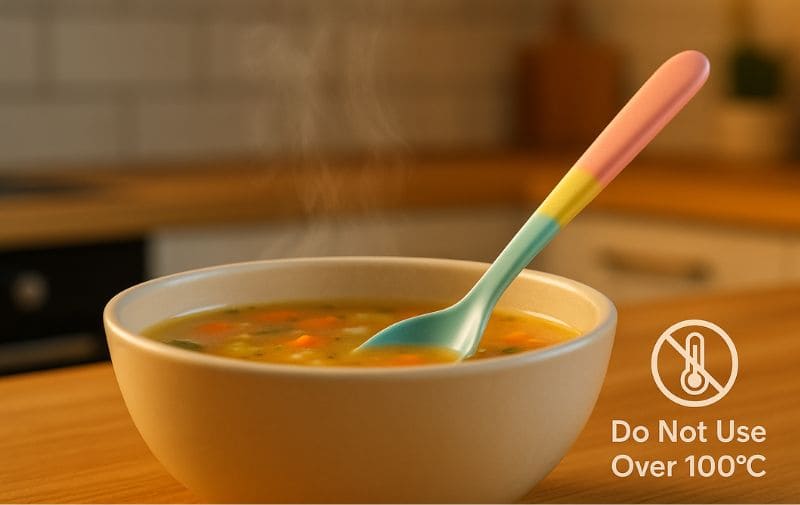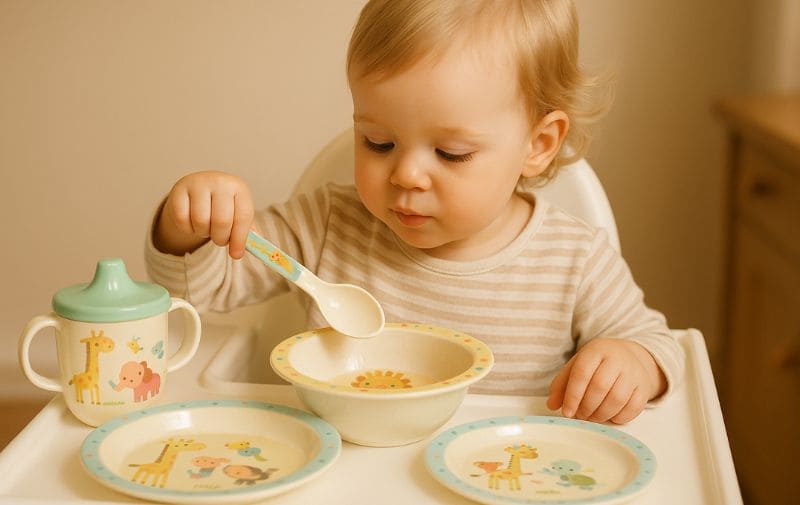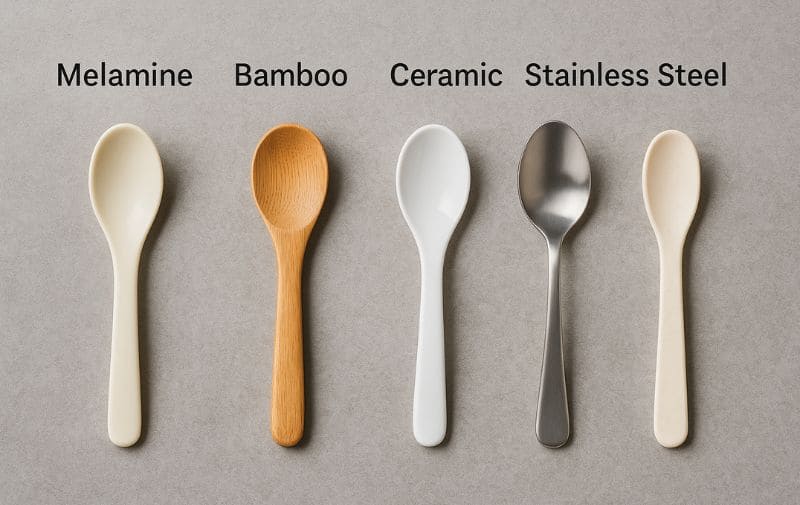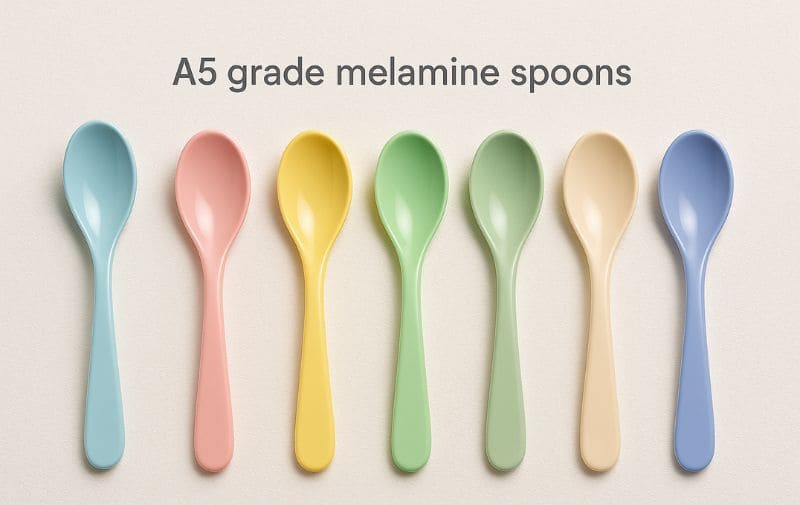Melamine spoons are everywhere – from your favorite ramen shop to your child’s cutlery drawer. They’re lightweight, durable, and come in endless colors. But a lingering question often arises: is it actually safe to eat from melamine spoons?
The direct answer is yes, it is overwhelmingly safe to eat from high-quality, certificated melamine spoons that are used as intended. The concerns about safety almost always stem from low-grade products or misunderstanding how the material behaves, especially with heat.
Last Updated: 19th.June 2025 | Estimated Reading Time: 11 Minutes

The Core Question: Is It Safe to Eat From Melamine Spoons?
Yes, spoons made from 100% A5 melamine or bamboo fiber are considered safe for food contact by regulatory bodies worldwide, including Organizations like the U.S. Food and Drug Administration (FDA) and the European Food Safety Authority (EFSA) have confirmed this. Their safety relies on the fact that during the curing process, the material becomes exceptionally stable, and any potential for chemical migration into food is minuscule—far below the very strict safety thresholds they have established.
The science supports this. When high-quality melamine resin is properly “cured” during manufacturing, the components become locked into a stable structure. The potential for these components to migrate, or “leach,” into food is minuscule and falls well below the extremely conservative safety limits set by health authorities.
Addressing the Formaldehyde Fear?
Yes, formaldehyde is a component used to create melamine resin. This word can be alarming, but context is key. In a properly manufactured and cured A5 melamine spoon, the formaldehyde molecules are chemically bonded and locked into a stable polymer structure. Think of it like baking a cake: ingredients like raw eggs might be unsafe on their own, but once baked into the final product, they are transformed into something entirely new, stable, and safe to eat.
What Exactly is a Melamine Spoon? It’s Not Just “Plastic”
Understanding the material is the first step to understanding its safety. A melamine spoon is a thermosetting plastic, which behaves very differently from the thermoplastics used for water bottles or disposable cutlery.
- Creation: It starts as melamine-formaldehyde resin powder.
- Molding: This powder is placed in a mold and subjected to intense heat and pressure.
- Curing: This process causes an irreversible chemical reaction. The material “cures,” setting into a permanently hard, rigid, and durable shape.
Unlike thermoplastics, a cured melamine spoon will not melt or warp when exposed to hot food. It remains stable, which is fundamental to its safety profile.
The A5 vs. A1/A3 Secret: The Most Important Thing 99% of Buyers Don’t Know
This is the single most important factor for melamine spoons safety, and it’s an industry secret every consumer and buyer needs to know. Not all melamine is created equal.
| Feature | A5 Melamine / Bamboo Fiber (Food-Safe) | A1/A3 Melamine (Non-Food-Safe) | What This Means For You |
|---|---|---|---|
| Composition | 100% Melamine-Formaldehyde Resin | Contains a high percentage of urea. | A5 is pure and stable; A1/A3 is a cheaper, less stable mix. |
| Safety | Approved for direct food contact. Passes LFGB/FDA tests. | NOT safe for direct food contact like spoons or bowls. | You must ensure your spoon is A5 grade or bamboo fiber |
| Appearance | High-gloss, smooth finish. Feels solid and dense. | Often has a duller finish, can feel lighter/more brittle. | A quality look and feel are good indicators of A5 grade. |
| Heat Resistance | Stable for hot food service (up to ~120°C / 250°F briefly). | Lower heat resistance; more likely to degrade and leach. | A5 handles soup and coffee; A1/A3 poses a risk with heat. |
Industry Insider Tip: The danger associated with melamine almost always comes from cheap, uncertified A1 or A3 grade spoons being sold improperly for food use. If a deal seems too good to be true, you are likely buying a non-food-safe product.
The Golden Rule: Why Temperature is Key for Safe Use
THeat is the most discussed factor when it comes to melamine. Here are the clear do’s and don’ts.

Safe for Hot Food, Not for High-Heat Cooking
A melamine spoon is perfectly safe for stirring a cup of hot coffee, eating a steaming bowl of pho, or serving a hot stew. The brief contact time does not allow the spoon to heat up to a point where its stability is compromised.
The misuse occurs when a melamine spoon is used as a cooking utensil.
- DON’T leave a melamine spoon resting in a simmering pot on the stove.
- DON’T use a melamine spoon to sauté or deep-fry.
Prolonged exposure to temperatures at or near boiling (100°C / 212°F) or direct pan heat can cause the material to degrade over time, increasing the potential for chemical migration.
Melamine and Microwaves: An Absolute “No”
You should NEVER put melamine spoons, bowls, or plates in the microwave. The microwave does not heat food evenly. It can create super-heated spots in the spoon itself, causing it to char, crack, and potentially leach chemicals into your food. This is the single most common form of misuse.
Are Melamine Spoons Safe for Babies and Young Children?
This is a top concern for parents, and rightly so. Yes, high-quality A5 grade melamine (bamboo fiber) spoons are an excellent and safe choice for children, which is why they are so popular. They are nearly unbreakable, lightweight, and dishwasher-safe.
However, parents should be extra vigilant:
- Confirm the Quality: Only purchase spoons that are explicitly marked 100% A5 Melamine, BPA-Free, and LFGB Certified or FDA compliant.
- Not a Teether: While durable, they are not designed to be chewed on like a silicone teether. Hard, repetitive chewing could eventually damage the surface. Discourage this behavior.
- Inspect Before Every Use: Run your finger over the spoon. Check visually for any chips, deep scratches, or cracks. If any damage is found, discard the spoon immediately to prevent injury and ensure hygiene.
Parent Tip: The rigidity of melamine is great for helping toddlers learn to scoop up foods like rice or peas, something a floppy silicone spoon can’t do as effectively.
How to Spot a High-Quality, Safe Melamine Spoon: A Buyer’s Checklist
You can become a savvy buyer by looking for these signs of quality:
| Quality Marker | What to Look For |
|---|---|
| Weight and Feel | Feels dense, solid, and has a satisfying heft. Not flimsy. |
| Surface Finish | A high-gloss, smooth, and flawless finish. |
| Markings & Labels | Marked “100% Melamine”, “A5 Grade”, “BPA-Free”, “Dishwasher Safe”. Look for LFGB Certified or FDA Compliant. |
| Price Point | Be wary of suspiciously cheap options. Safety has a small premium. |
The Practical Advantages: Why People Choose Melamine Spoons
Beyond safety, melamine spoons offer a superior user experience, which is why chefs and families love them.
- No Heat Transfer: Unlike a metal spoon, it won’t get scalding hot when sitting in a bowl of soup for a few minutes.
- Better “Mouthfeel”: The surface is smoother and warmer than the hard “clank” of metal against teeth or bowls.
- Non-Porous: It won’t absorb stains, flavors, or odors like wood can, and it won’t splinter. It’s also fully dishwasher safe.
- Rigidity: It’s much better for scooping solid foods like rice or thick chili where a flexible silicone spoon would fail.
Chef’s Tip: Many chefs prefer using melamine tasting spoons because they don’t impart a metallic taste to the food, providing a cleaner, more accurate flavor profile.

When to Retire a Melamine Spoon? A Visual Guide
Safety relies on an intact surface. It’s time to discard your spoon if you see:
- Deep Scratches: Run your fingernail across the surface. If it catches in a groove, that scratch is deep enough to potentially harbor bacteria.
- Chips or Cracks: Any break in the surface, especially on the edge of the spoon, compromises its integrity.
- Dull, Pitted Surface: If the spoon has lost its gloss and feels rough or chalky from years of use and dishwasher cycles, its protective surface is worn down.
- Stains That Won’t Budge: While A5 is very stain-resistant, deep-set stains in a scratched or worn spoon can indicate the surface is compromised.
Comparison: Melamine Spoons vs. Other Materials
How does melamine stack up against the alternatives? This chart breaks it down.
| Feature | A5 Melamine | Stainless Steel | Silicone | Wood/Bamboo |
|---|---|---|---|---|
| Durability | Excellent (Chip/break resistant) | Excellent (Can bend but won’t break) | Excellent (Cannot break or chip) | Fair (Can crack, splinter over time) |
| Heat Use | Good for eating/serving hot food; No cooking | Excellent for cooking and eating | Excellent for cooking and eating | Poor (Can burn, degrade with heat) |
| Mouthfeel | Excellent (Smooth, no heat transfer) | Fair (Conducts heat, can feel hard/cold) | Good (Soft, flexible) | Good (Natural, warm feel) |
| Hygiene/Cleaning | Excellent (Non-porous, dishwasher safe) | Excellent (Non-porous, dishwasher safe) | Excellent (Non-porous, dishwasher safe) | Fair (Porous, can absorb stains/odors, hand-wash) |
| Best For | Eating soups, rice, kids’ meals, serving | All-purpose cooking and eating | Cooking (stirring), babies, baking | Serving salads, gentle use |

Final Verdict: Use Melamine Spoons with Confidence and Knowledge
You absolutely should feel confident using melamine spoons in your daily life. They offer a unique combination of durability, functionality, and aesthetic appeal that other materials can’t match.
The key is not to fear the material, but to be an educated consumer.
- BUY SMART: Invest in high-quality, certified A5 grade spoons from reputable brands.
- USE SMART: Use them for their intended purpose—eating and serving, not cooking or microwaving.
- CARE SMART: Wash them with non-abrasive sponges and retire them if they become damaged.
By following this advice, you can enjoy all the benefits of melamine spoons without any of the worry.
Frequently Asked Questions (FAQ)
Q1: Are melamine spoons toxic?
A: No, this is a myth. High-quality A5 melamine spoons that are FDA or LFGB certified are non-toxic and perfectly safe for eating. The risk comes from uncertified, low-grade (A1/A3) melamine, which is not intended for food use.
Q2: Are melamine spoons BPA-free?
A: Yes, true melamine is a completely different chemical from polycarbonate, which contains Bisphenol-A (BPA). All 100% melamine products are inherently BPA-free. Reputable brands label this clearly for consumer confidence.
Q3: Can I use a melamine spoon for my tomato soup? Will the acid cause problems?
A: Yes, you can. The brief contact time from eating acidic foods like tomato soup, citrus, or vinegar-based dressings will not harm a high-quality A5 melamine spoon. The material is designed to be resistant to food acids during normal use.
Q4: What does “LFGB Certified” mean for a melamine spoon?
A: LFGB is the German food safety standard. It is widely considered to be one of the strictest in the world. While both FDA and LFGB compliance indicate a product is safe, an LFGB certification often means the product has passed more rigorous testing for chemical migration, making it a gold standard for quality assurance.
Q5: Why do my old white melamine spoons have coffee stains? Are they still safe?
A: Light surface staining on an otherwise intact spoon is usually just an aesthetic issue. However, if the stains are deep-set and the spoon’s surface feels rough or is scratched, it indicates the protective glaze has worn down. In this case, it’s best to replace the spoon for optimal hygiene.
Recommended
- Looking for Certified A5 Melamine Spoon Collection
- FDA Guidance on Melamine in Tableware – The official stance from the U.S. Food and Drug Administration.
- What is Melamine Resin? (Wikipedia) – For a deeper dive into the material science.



